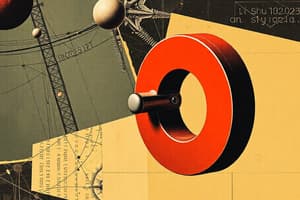Podcast
Questions and Answers
What force causes a rolling ball to eventually stop on the ground?
What force causes a rolling ball to eventually stop on the ground?
- Gravitational force
- Frictional force (correct)
- Magnetic force
- Electrostatic force
If there was no friction, which of the following would be most difficult?
If there was no friction, which of the following would be most difficult?
- Walking on the ground (correct)
- Hearing sounds
- Using electromagnets
- Squeezing a ball
Which of these is NOT an expected effect of a force acting on an object?
Which of these is NOT an expected effect of a force acting on an object?
- Changing its color (correct)
- Changing its direction
- Changing its shape
- Causing it to move
What is a primary function of magnets in telephones, headphones and speakers?
What is a primary function of magnets in telephones, headphones and speakers?
What is a key characteristic of elektromagnets, differentiating them from permanent magnets?
What is a key characteristic of elektromagnets, differentiating them from permanent magnets?
What is the name of the rock that can pull things made of iron towards itself?
What is the name of the rock that can pull things made of iron towards itself?
Which of these is NOT a magnetic material?
Which of these is NOT a magnetic material?
What do we call the ends of the magnet?
What do we call the ends of the magnet?
What is the result when two like poles of a magnet are brought together?
What is the result when two like poles of a magnet are brought together?
What is a force?
What is a force?
Which of these options best describes friction?
Which of these options best describes friction?
Which part of a magnet possesses the strongest attractive force?
Which part of a magnet possesses the strongest attractive force?
What happens when unlike poles of two magnets are brought together?
What happens when unlike poles of two magnets are brought together?
Flashcards
Friction
Friction
A force that opposes motion between two surfaces in contact.
Force
Force
A push or pull that can change an object's motion, shape, or direction.
Electromagnet
Electromagnet
A type of magnet that can be turned on and off with electricity.
Magnetic Force
Magnetic Force
Signup and view all the flashcards
Motion
Motion
Signup and view all the flashcards
What is a magnet?
What is a magnet?
Signup and view all the flashcards
What are magnetic materials?
What are magnetic materials?
Signup and view all the flashcards
What are non-magnetic materials?
What are non-magnetic materials?
Signup and view all the flashcards
What are the poles of a magnet?
What are the poles of a magnet?
Signup and view all the flashcards
What happens when like poles of magnets interact?
What happens when like poles of magnets interact?
Signup and view all the flashcards
What happens when unlike poles of magnets interact?
What happens when unlike poles of magnets interact?
Signup and view all the flashcards
What is a force?
What is a force?
Signup and view all the flashcards
What is friction?
What is friction?
Signup and view all the flashcards
Study Notes
Magnets: Properties and Uses
- Magnets are objects made of special materials (like iron, nickel, cobalt, and steel) that can pull or attract other magnetic materials.
- Some magnets are natural (like magnetite), while others are man-made from iron or steel and can be various shapes (e.g., U-shaped, horseshoe, bar).
Magnet Interactions
- Magnets attract certain materials (magnetic materials).
- Non-magnetic materials are not attracted to magnets (e.g., gold, silver, aluminium, wood, paper).
- Magnets have two poles: north (N) and south (S).
- Like poles (N-N or S-S) repel each other.
- Unlike poles (N-S) attract each other.
Force and Magnets
- A force is a push or pull.
- Magnets exert forces on other magnetic materials.
- Magnetic forces are strongest at the poles of the magnet.
- Interactions between magnets result in forces of attraction or repulsion.
Types of Forces and Effects
- Friction is a force that slows or stops moving objects.
- Forces can change an object's motion (start, stop, or change speed/direction).
- Forces can change an object's shape or size.
Magnet Uses
- Magnets are used in many everyday devices: telephones, headphones, speakers, computers, video recorders, refrigerators.
- Electromagnets are temporary magnets that become magnetic when electricity flows through them.
Studying That Suits You
Use AI to generate personalized quizzes and flashcards to suit your learning preferences.




